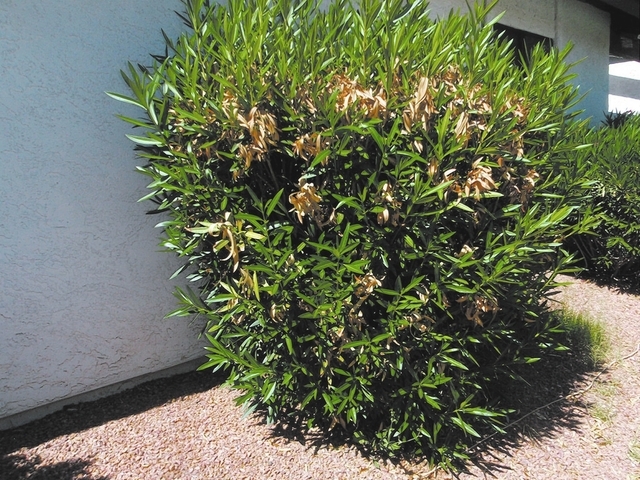Damage to covered oleanders may be minimal

Reports from the weather station at the University of Nevada Cooperative Extension orchard in North Las Vegas put the low temperatures Dec. 6 and 10 at 20 F with daytime highs around the same as the inside of a refrigerator. I am sure this caused some damage to plants. I posted the weather report on my blog for those interested.
Q. I believe I messed up with my 1-year-old oleanders. I covered them with old cotton bed sheets and then plastic bags thinking it would protect them. When I uncovered them, the sheets were frozen with what I assume was condensation caused by the plastic bags. I’m hoping they survive as much of the lower foliage is still green and soft. What is my next option?
A. I don’t think you made a mistake. They just froze, that’s all. Nine times out of 10 they will come back in the spring. In fact the freezing bed sheet gave the oleander a few extra degrees of warmth.
Wait until spring and new growth before making any decisions. It is possible the oleander just got some leaf and the stem death with some of the stems still alive. You will not know until it starts growing again, but I don’t think you lost them.
The degree of damage to a plant will depend on the plant itself, its variety, how it was cared for, weather before the freeze, landscape microclimate, the minimum temperature reached and the duration of that temperature. It can be really difficult to predict the degree of damage done for quite some time.
There may still be some cold coming later in the winter. Sometimes freezing temperatures in February, when plants are preparing for spring, can be much worse than the same temperatures in December or January.
Don’t prune them back just yet. Be patient and see what spring brings.
Q. We have a couple of pyracantha bushes. We noticed this past summer some small, pen-point-sized, bright green bugs on the end of the branches. A day or two later I noticed ants in those same places but couldn’t tell if they were eating the bugs or not. Please advise if we need to do something.
A. From the sound of it the bush had aphids, sometimes called plant lice, but summer is not the usual time that aphids appear. Aphids normally appear with new growth in the spring and disappear when it gets hot.
Ants are attracted to aphids because the aphids release sugary honeydew when they’re feeding on the pyracantha leaves. Ants “farm” the aphids, take this honeydew excretion and use it. So you may see ants traveling up and down the pyracantha gathering and transporting honeydew to their nest in the soil. Ants may even move the aphids around to new locations to expand their “herd.”
It’s not a big problem if these are just aphids. The aphids will cause some stickiness on the leaves and may cause leaves to fall from the plant if the feeding becomes heavy. But that time of year I would not expect them to be a big problem.
If the problem is excessive, the easiest thing to do is mix some soap and water, about as much as you would use when you would wash your dishes. Put it in a spray bottle and spray the soapy mixture directly on these green bugs, usually on the underside of the leaves.
You will probably have to do this every couple of days since soap and water do not leave any poisonous residue on the leaf surface and these spots will repopulate quickly after the spraying is done.
If you want more permanent control then you can use a traditional insecticide that has a label listing ornamental plants and aphid control. You also can treat the ant nest in the soil. Pouring boiling water on the ant hill will give some temporary organic control of the ants.
Q. We purchased 11 tipu trees in March 2012. We purchased these trees because they were recommended as fast-growing trees for our property. Three of the 11 trees we planted died last winter and only grow “suckers” around the base of the trunks. An arborist told us the trees were “toast” and recommended we might leave the suckers to regrow into a tree rather than remove them. Is there anything else we can do to help these trees or do you think they are a lost cause?
A. As you have already found out, this tree will freeze in our climate. This is what I believe killed the tops of your trees this past winter. According to Arizona State University, the tipu is hardy down to about 25 F. Temperatures below this cause winter leaf drop first followed by branch and trunk death as temperatures drop further.
What you are seeing is resprouting of the tree from the base, which was protected from freezing temperatures by the soil. If the temperature had dropped even further you might have lost the entire tree with no regrowth from suckers.
The arborist was right. You could select one of the stronger suckers and remove the rest. If you want a multitrunked tree then leave three to five. These nurtured suckers will grow up to be a new tree that will promptly freeze to the ground again when temperatures drop to that 20 degree range.
I am not in favor of growing this tree here. This tree is originally from South America where it can reach heights of 100 feet with a 60-foot spread. In our harsh, desert climate, it won’t get that tall but might reach 40 feet or so.
In the wetter parts of California, it has been used in water conservation landscapes. It is not a desert plant and should not be considered low water use and in the same category as acacias for instance.
These trees should be considered moderate in their water use, similar to ash of a similar size.
In some places they are considered invasive and their root systems destructive. This should not be the case here if you plant them several feet from walls, sidewalks, driveways and foundations. Plus, you should water them infrequently, not with shallow frequent irrigations, and irrigate on sides away from structures to lessen damaging root growth.
A lot of people in the warmer Phoenix area like this tree. In a nutshell, because of its lack of cold hardiness, I do not believe it is suitable for the cooler climate of the Las Vegas Valley.
Bob Morris is a horticulture expert living in Las Vegas and professor emeritus for the University of Nevada. Visit his blog at xtremehorticulture.blogspot.com.


















